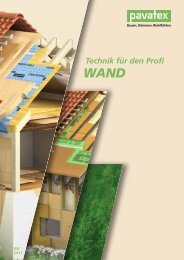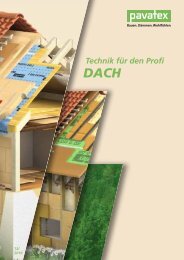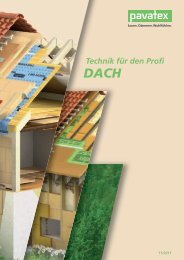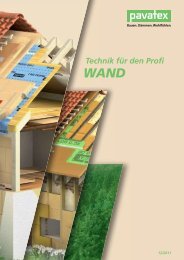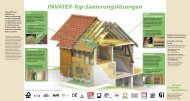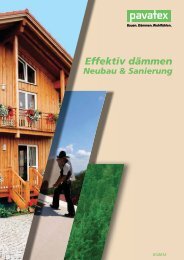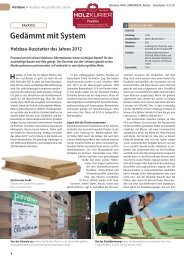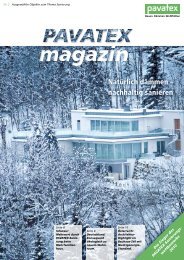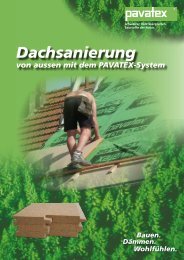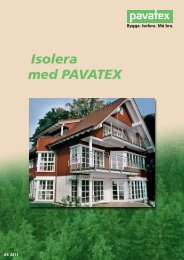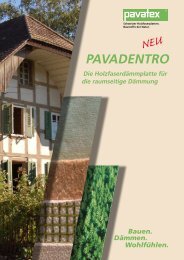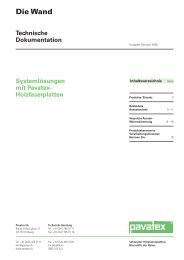PAVACLAD & DIFFUTHERM - Pavatex
PAVACLAD & DIFFUTHERM - Pavatex
PAVACLAD & DIFFUTHERM - Pavatex
You also want an ePaper? Increase the reach of your titles
YUMPU automatically turns print PDFs into web optimized ePapers that Google loves.
Steel Frame Systems<br />
<strong>PAVACLAD</strong> &<br />
<strong>DIFFUTHERM</strong><br />
The Science of Nature<br />
The Future of Construction
2<br />
NBT Steel Frame Systems – Introduction<br />
Content<br />
Description of Steel Frame Systems 2<br />
Performance Guide 3<br />
Air Tightness 4<br />
Summer Overheating 5<br />
<strong>PAVACLAD</strong><br />
System Build up 6<br />
Physical Properties 7<br />
Key Considerations - Designers 8<br />
Key Considerations - Installer 9<br />
Installation Procedures 10<br />
Components & Accessoires 13<br />
Detail Drawings <strong>PAVACLAD</strong> 15<br />
Specification <strong>PAVACLAD</strong> 19<br />
<strong>DIFFUTHERM</strong><br />
System Build up 20<br />
Physical Properties 21<br />
Key Consideration - Designers 22<br />
Key Consideration - Installers 23<br />
Installation Procedures 24<br />
Detail Solutions 26<br />
Components & Accessories 27<br />
Detail Drawings <strong>DIFFUTHERM</strong> 31<br />
Specification <strong>DIFFUTHERM</strong> 37<br />
Product Overview: Insulation 39<br />
w<br />
No limits to architectual design: <strong>PAVACLAD</strong> and <strong>DIFFUTHERM</strong><br />
facades interact together<br />
Description of<br />
NBT Steel Frame Systems<br />
The NBT steel frame system is adaptable to all<br />
external finishes: The <strong>PAVACLAD</strong> system which<br />
is an external insulation with cladding and the<br />
<strong>DIFFUTHERM</strong> system which is an external insulation<br />
with render.<br />
Made from over 95 % waste softwood and under 5 %<br />
inert water-proofing additives, PAVATEX woodfibre boards<br />
(PAVATHERM, <strong>DIFFUTHERM</strong>, PAVATHERM-PLUS + , ISOLAIR)<br />
are a genuinely sustainable non-toxic building material.<br />
To produce PAVATEX boards, waste wood fibres are pulped<br />
and mixed with water. The pulp is heated to activate the<br />
natural lignin they contain in order to glue the fibres together.<br />
The pulp is then pressed into boards, dried, and cut to size.<br />
The advanced manufacturing process uses the inherent<br />
properties of wood fibres to produce boards with many<br />
excellent technical qualities for thermal and acoustic<br />
insulation, thermal storage capacity, vapour permeability<br />
and moisture control.
Performance Guide<br />
A modern wall insulation system must do more than<br />
just protect building occupants from cold. It must<br />
create a comfortable and healthy environment in<br />
all possible combinations of external and internal<br />
conditions and control the effects of external heat,<br />
cold, noise and internal moisture generation.<br />
NBT <strong>PAVACLAD</strong> & <strong>DIFFUTHERM</strong><br />
Systems...<br />
Keep the building warmer for longer in cold weather:<br />
Low thermal conductivity and high vapour permeability<br />
provide high thermal insulation with no risk of interstitial<br />
condensation. Vapour barriers are unnecessary. Wood<br />
fibre boards reduce the effect of thermal bridging and<br />
the interlocking board design easily achieves good windtightness,<br />
so increasing thermal performance. Energy use<br />
for heating is significantly reduced leading to lower CO 2<br />
emissions and running costs.<br />
Keep the building quieter:<br />
The high mass and the fibrous texture of PAVATEX woodfibre<br />
boards gives excellent acoustic performance to buildings.<br />
Keep the building cooler in hot weather:<br />
The unique combination of high density, high specific<br />
heat capacity and low thermal conductivity gives External<br />
Wall Insulation (EWI) solutions the effect of thermal mass<br />
that would normally be associated with render onto<br />
masonry. Compared to conventional EWI material the risk<br />
of condensation behind the render during cold nights is<br />
minimized as the boards will store the day’s heat.<br />
Keep the building dry and breathable:<br />
PAVATEX woodfibre boards are very vapour permeable and<br />
hygroscopic. This allows them to disperse accumulating<br />
short term moisture and protect vulnerable elements of the<br />
building fabric, with no reduction in the performance of the<br />
boards themselves. The boards allows moisture from within<br />
the structure to pass easily to the outside. This provides a<br />
safeguard against high moisture content. This is vital for the<br />
long-term health of the building fabric, and is completely<br />
overlooked by most conventional insulation systems.<br />
NBT Natural Insulation Products for:<br />
Simple and robust<br />
Highly vapour permeable constructions that do not<br />
need membranes to control interstitial condensation<br />
Excellent sound insulation for light weight structures<br />
Improved heat storage for light weight structures<br />
Substantial saving of build cost compared with conventional<br />
steel frame construction<br />
Simple robust construction has few skilled operations and is<br />
easily adapted for offsite manufacture<br />
Reduced thermal bridging - ideal to achieve<br />
new Building Regulation part L<br />
For more information please visit www.natural-building.co.uk<br />
3
4<br />
Air Tightness<br />
Principle<br />
A building envelope should be air tight when all ventilation<br />
openings are closed. The design requirement for air changes<br />
has to be provided by opening the windows manually, other<br />
controllable ventilation openings or suitable mechanical<br />
ventilation systems.<br />
When assessing the air permeability of the building<br />
envelope, the following aspects must be considered<br />
separately:<br />
• Individual building components must exhibit the<br />
necessary air tightness in accordance with building<br />
component standards<br />
• The overall air permeability of the building envelope<br />
must meet the limiting and target values of building<br />
regulations<br />
• Local air permeability (leaks, primarily on the inside)<br />
can lead to moisture damage because they allow moist<br />
interior air to infiltrate the construction<br />
• Local air permeability and associated draughts can<br />
have a detrimental effect on the thermal comfort of<br />
the occupants and can also lead to increased energy<br />
consumption<br />
Air permeability<br />
The air permeability of the building envelope is specified<br />
by the ratio of surface area of the building to the hourly<br />
air exchange rate for a 50 Pa pressure difference. In Part<br />
L Building Regulations an air permeability of 10.0 m 3 /<br />
m 2 /h is allowed, for EST best practice for CSH level 3 an<br />
air permeability of 3.0 m 3 /m 2 /h, for higher CSH levels<br />
an air permeability of 1.0 m 3 /m 2 /h are accepted as the<br />
maximum.<br />
Design and construction<br />
To ensure that the building envelope has the necessary<br />
degreee of air thightness, an air tightness layer is required<br />
over all parts of the construction on the warm side of the<br />
thermal insulation. Generally, the vapour control layer<br />
and airtight layer funtions are combined and provided by<br />
one membrane, sheeting or a board type material (OSB,<br />
multi-ply board, plywood, gypsum fibreboard, etc.). Such<br />
materials require fixings and permanent air tight seals at<br />
joints and junctions in the form of adhesive tape, glue,<br />
mechanical fasteners etc., or may need to be held in place<br />
with battens.<br />
Rock wool and glass-fibre boards, wood fibreboards,<br />
wooden panelling, planking, acoustic linings,<br />
building papers etc. cannot achieve the degree of air<br />
tightness required.<br />
The air tightness layer must be conceived at the design stage<br />
as a “seamless” layer over the entire building envelope,<br />
planned with its practical installation in mind, and shown<br />
as a separate layer on all drawings. Good planning includes<br />
corresponding<br />
information in<br />
the tender documents<br />
and detail<br />
in the working<br />
and fabrication<br />
drawings. The<br />
materials used to<br />
achieve the air<br />
tightness must<br />
be sealed airtight<br />
at junctions<br />
with adjoining<br />
w<br />
Sketch of the principle of an air tightness<br />
layer<br />
elements such as<br />
windows, doors<br />
and foundations. The installation of several layers each of<br />
which are only partially airtight will not result in a building<br />
with an adequate degree of sealing.<br />
Testing<br />
In order to achieve an air tight building envelope, measures<br />
and checks during construction and after completion of<br />
the building are necessary. If the air tightness layer has<br />
been properly designed and planned, expensive blower<br />
door measurements, leak detection by means of smoke<br />
tests or IR thermography, and unnecessary costs of repairs<br />
can be saved.<br />
A properly designed and constructed building will<br />
fulfil air tightness requirements without the need for<br />
further special work.
Summer Overheating<br />
Selecting the right insulation<br />
As part of a building’s design it is important to<br />
consider the effects of summer overheating control,<br />
particulary when there are rooms in roofs or where<br />
the construction sysetem is lightweight such as steel<br />
or timber frame.<br />
Summer overheating is caused by any or a combination of<br />
three reasons:<br />
• too great internal gains from appliances, people,<br />
machines etc.<br />
• too much sun directly through windows due to poor<br />
summer shading<br />
• heat passing directly through the walls<br />
The solution to the first is to reduce the gains or ventilate,<br />
the second requires better shading,<br />
and the third is solved by reducing peak<br />
55<br />
heat gain to the room by changing the<br />
decrement delay and factor.<br />
50<br />
45<br />
Decrement delay and factor can be<br />
thought of as the amount a peak<br />
40<br />
external surface temperature is<br />
35<br />
Temperature o C<br />
30<br />
25<br />
20<br />
15<br />
smoothed out by the structure, and the time that the peak<br />
is delayed before it reaches the inside.<br />
To reduce the solar heat passing through a roof or a wall, a<br />
low decrement factor is needed, and more importantly, it<br />
should delay the passage of heat by between 6 - 12 hours<br />
after the external solar radiation peak – this means that<br />
the decrement delay of a wall or roof construction should<br />
be between 6 - 12 hours.<br />
In terms of achieving these satisfactory values, an insulation<br />
material that has a high thermal mass is needed to<br />
produce better values. A combination of density, thermal<br />
conductivity and specific heat capacity is required.<br />
PAVATEX woodfibre boards have an excellent combination<br />
Te mperatur on the inside surface<br />
10<br />
6h 9h 12h 15h 18h 21h 24h 3h 6h<br />
Day 1 Day 2<br />
of low l D (k-value) (0.038 - 0.047 W/m²K), high specific<br />
heat capacity (2100J/kgK) and for insulation boards a high<br />
density (140 - 240 kg/m³). These values far exceed any<br />
conventional insulation material. This means that with<br />
PAVATEX woodfibre insulation a roof or “lightweight”<br />
structure such as lightweight frame building can perform<br />
as though it was a much more massive structure.<br />
The consequence is the reduction of internal temperatures<br />
by 4° C or more in summer compared to a room which<br />
may have the same u-value but conventional insulation.<br />
For more information please visit www.natural-building.co.uk<br />
External amplitude<br />
Decrement delay (time lag)<br />
Temperatur on the external surface of the wall<br />
Internal amplitude<br />
5
6<br />
<strong>PAVACLAD</strong> System<br />
Plasterboard and skim<br />
Service void<br />
PAVATHERM<br />
OSB to support PAVATHERM and for<br />
vapour control and air tightness<br />
PAVATHERM<br />
PAVATHERM-PLUS +<br />
PAVATHERM<br />
PAVATHERM<br />
PAVATHERM-P<br />
PAVATHERM-PLUS<br />
PAVATHERM PAVATHERM-PLUS lus<br />
Battens<br />
(ventilation)<br />
Steel stud<br />
Cladding or<br />
rainscreen
<strong>PAVACLAD</strong> – Physical Properties<br />
Physical Properties <strong>PAVACLAD</strong><br />
1. 2. 3. 4. 5. 6. 7.8.<br />
100 mm stud<br />
Warm frame<br />
Insulation onto stud PAVATHERM-PLUS +<br />
1. Cladding system (timber, brick, screen etc.)<br />
2. Battens 40 x 40 mm<br />
3. PAVATHERM-PLUS + 60/80/100 mm<br />
4. PAVATHERM 60/80/100 mm<br />
5. OSB board (support & air tightness)<br />
6. Steel stud 65 - 250 mm<br />
7. Plasterboard 12.5 mm<br />
8. Plaster, skim and NBT emulsion paint<br />
100 mm 120 mm 140 mm 160 mm 180 mm 200 mm<br />
U-Value [W/m²K] 0.35 0.28 0.25 0.22 0.20 0.19<br />
Admittance [W/m²K] 1.42 1.42 1.42 1.42 1.42 1.42<br />
Sound insulation ca. [dB] 45 46 47 47 48 48<br />
Decrement delay [h] 6.2 7.2 8.6 9.9 11.3 12.6<br />
Calculations are done according to EN ISO 6946:2008 and are based on studs at 600 mm centres. 120 mm insulation layer onto studs is made of PAVATHERM<br />
60 mm & PAVATHERM-PLUS + 60 mm; 160 mm insulation layer onto studs is made of PAVATHERM 80 mm & PAVATHERM-PLUS + 80 mm; 200 mm insulation layer<br />
onto studs is made of PAVATHERM 100 mm & PAVATHERM-PLUS + 100 mm.<br />
For more information please visit www.natural-building.co.uk<br />
7
8<br />
<strong>PAVACLAD</strong> – Designers: Key Considerations<br />
General:<br />
The <strong>PAVACLAD</strong> System must only be installed by competent<br />
contractors. Provide the contractor with full and complete<br />
details for all critical areas of the system including those<br />
listed below - leave nothing‚ to be agreed “on site“.<br />
System Guarantee:<br />
The system is guaranteed if only boards and accessories<br />
approved by NBT are used. <strong>PAVACLAD</strong> system has LANTAC<br />
(Local Authority National Type Approval Confederation)<br />
and BBA (British Board of Agrément) approval (BBA<br />
CERTIFICATE No 08/4549).<br />
DPC-Level:<br />
Do not use PAVATHERM-PLUS + or PAVATHERM boards<br />
below DPC level.<br />
Building Height:<br />
The <strong>PAVACLAD</strong> System is certified for use in buildings<br />
where the height to the top floor is < 18 m. If intended for<br />
use in higher buildings, contact NBT for advice.<br />
Non Load Bearing:<br />
The <strong>PAVACLAD</strong> system must be designed so that no loads<br />
from the structure are carried by the boards or cladding<br />
system.<br />
Ensure that any cladding system/protection screens are<br />
securely fixed back to the frame.<br />
Carefully plan the location of down-pipes, lights, security<br />
systems etc. and attach fixing discs screwed directly to<br />
the structure where the attachment is<br />
more than can be carried directly by<br />
the cladding (i.e. cast iron guttering).<br />
Contact NBT for further advice on<br />
fixings.<br />
Movement Joints:<br />
Movement joints in the substrate<br />
must be incorporated into the<br />
<strong>PAVACLAD</strong> system. Consider<br />
movement joints for wall<br />
elevations > 18 m.<br />
Weather tightness:<br />
For weather tightness seal the boards against the structure<br />
at all joints, intersections, openings and penetrations and<br />
along all edges using Compriband.<br />
For water tightness, seal all exposed board edges, openings,<br />
corners etc. with PAVATEX PRIMER and PAVATAPE<br />
(Installation Procedure <strong>PAVACLAD</strong>, page 10 - 14).<br />
Rain Penetration:<br />
Design a positive strategy for avoiding rain penetration of<br />
the <strong>PAVACLAD</strong> system. This will include:<br />
•<br />
•<br />
•<br />
•<br />
Generous overhangs for roofs, cills and copings (in no<br />
case < 30 mm)<br />
Drip details on all overhangs<br />
Careful detailing of flashings at critical areas eg.<br />
balconies, decks, walkways, parapets, copings,<br />
service penetrations, roof abutments, intersecting and<br />
adjoining buildings, etc.<br />
Window and door frames set back from the external<br />
face of the wall by at least the thickness of the<br />
insulation boards.<br />
Air tightness:<br />
Carefully detail the OSB layer for air tightness at all openings<br />
and at internal corners and junctions.
<strong>PAVACLAD</strong> – Installers: Key Considerations<br />
General:<br />
The <strong>PAVACLAD</strong> System must only be installed by competent<br />
contractors.<br />
The details and specifications in this guide and from the<br />
designer should be followed as the basis for a successful<br />
installation.<br />
The system can be guaranteed only if boards and accessories<br />
approved by NBT are used in the specified manner.<br />
Movement joints in the substrate must be incorporated<br />
into the <strong>PAVACLAD</strong> system.<br />
Carefully plan the location of down-pipes, lights, security<br />
systems etc. and attach fixing discs screwed directly to<br />
the structure or fix battens where the attachment is more<br />
than can be carried directly by the cladding (i.e. cast iron<br />
guttering). Contact NBT for further advice on fixings.<br />
Boards:<br />
Plan board layout to reduce wastage prior to commencing<br />
installation.<br />
Boards must span at least 2 studs. Board edges need<br />
not coincide with stud positions, which should be at<br />
< 650 mm centres. Minimum bond overlap is 200 mm<br />
between courses.<br />
Boards must not be wet or damaged and board edges<br />
must be tightly butted together.<br />
Tightly fill all gaps between boards with woodfibre and<br />
seal area with PAVATEX PRIMER and PAVATAPE (Installation<br />
Procedure <strong>PAVACLAD</strong>, page 12 - 14).<br />
For weather tightness seal the boards against the structure<br />
at all joints, intersections, openings and penetrations and<br />
along all edges using Compriband.<br />
For all exposed board edges, openings, corners etc. use<br />
PAVATEX PRIMER and PAVATAPE.<br />
Do not use the <strong>PAVACLAD</strong> system below DPC level.<br />
Do not allow the boards to stand exposed to weather for<br />
more than 90 days after fixing before applying the cladding<br />
system.<br />
Cladding:<br />
Ensure that any cladding system/rain screens are securely<br />
fixed back to the frame.<br />
Only use the fixings recommended by NBT.<br />
The cladding system should offer weather protection to<br />
the system and it should be detailed so as to allow an<br />
unobstructed flow of air ventilation to the void between<br />
the cladding and the face of the <strong>PAVACLAD</strong> system<br />
boards.<br />
Thermal insulation<br />
Heat protection<br />
PAVATEX wood fibre insulation<br />
boards provide overall protection,<br />
and lead to vapour open<br />
constructions<br />
For more information please visit www.natural-building.co.uk<br />
Noise dampening<br />
9
10<br />
<strong>PAVACLAD</strong> – Installation Procedures<br />
Cutting:<br />
The boards are easily cut with any of the following tools:<br />
• PAVATEX jigsaw blades (bayonet fitting to suit most<br />
makes of jigsaw)<br />
• Standard wave edge insulation knife<br />
• Circular saw, hand-held or bench mounted with a<br />
fine, cross-cut, tungsten tipped blade<br />
Safety goggles and dust mask must be worn during cutting<br />
to protect the user from the small, non hazardous, dust<br />
particles.<br />
Fixing:<br />
Fix OSB boards using<br />
fixings according<br />
to the engineers<br />
specifications into<br />
steel stud. In case<br />
more than 100 mm of<br />
insulation is used fix<br />
PAVATHERM using 2<br />
fixings per board into<br />
OSB.<br />
Fix first row of<br />
PAVATHERM-<br />
PLUS + with tongue<br />
uppermost using 1<br />
- 2 fixings per board<br />
(through PAVATHERM)<br />
into OSB. Final fixing<br />
occurs through batten<br />
into steel frame except<br />
with brick clad facades<br />
(see fixings guidelines)<br />
Damaged boards and butt edged joints:<br />
Any damaged areas and “butt edged” joints in the<br />
PAVATHERM-PLUS + layer should be filled tightly with<br />
woodfibre offcuts - primed and taped with PAVATAPE<br />
to ensure the integrity of the layer and to prevent water<br />
ingress (see using PAVATAPE section on page 11).<br />
Openings, corners and penetrations:<br />
All openings, corners and penetrations should be primed<br />
and taped with PAVATAPE to ensure the integrity of the<br />
layer and to prevent water ingress (see using PAVATAPE<br />
section on page 11).<br />
Fix subsequent<br />
rows ensuring that<br />
the tongue is fully<br />
engaged. Fix as first<br />
row<br />
> 200 mm<br />
Boards must be<br />
installed with a<br />
minimum 200 mm<br />
staggered bond<br />
Boards must span at<br />
least 2 studs behind<br />
OSB board. Board<br />
edges need not<br />
coincide with stud<br />
positions, which<br />
should be at < 650<br />
mm centres. Use a<br />
plumb line for marking<br />
positioning of fixing of<br />
batten to ensure fixing<br />
goes into studs behind<br />
OSB board.<br />
Movement joints:<br />
Movement joints must be provided for wall elevations ><br />
18 m. After the whole wall section has been fitted cut a<br />
5 mm wide groove through the board on the centre line<br />
of a stud. Seal over the groove with PAVATAPE to form a<br />
sealed air gap.
Using Pavatape:<br />
Guidelines for use<br />
• Only use PAVATAPE on dry, clean and dust-free<br />
substrates<br />
• Use after fitting boards and always BEFORE installing<br />
battens<br />
• Two priming solutions are available dependent on<br />
weather conditions: For temperatures between 5 -<br />
10º C use solvent based PRIMER and use water based<br />
PRIMER at temperatures above 10° C<br />
• PAVATAPE should not be applied if the temperature is<br />
below 5º C - Contact NBT for Guidance.<br />
• Apply PAVATEX PRIMER with a brush or roller onto<br />
the board and abutments and allow to dry: Waterbased<br />
PRIMER is temperature sensitive - drying time<br />
is between 30 and 60 minutes (at 20º C ca. 30 min<br />
and at 5º C ca. 60 min). Drying time for solvent based<br />
PRIMER is 20 minutes.<br />
• Store PAVATEX PAVATAPE rolls on a flat surface in a<br />
dry dust-free environment.<br />
• Shelf life when stored at around 20º C is unlimited<br />
for PAVATAPE. PRIMER needs to be used within 12<br />
months after manufacture.<br />
When to use<br />
System change<br />
How to install<br />
PAVATAPE self<br />
adhesive butyl tape<br />
15 m long x 150<br />
mm wide<br />
For more information please visit www.natural-building.co.uk 11<br />
1<br />
Clean surface with a<br />
brush. Surface MUST<br />
be dry to ensure good<br />
adhesion (use of hot<br />
air gun to dry board)<br />
1 2 3<br />
Apply PRIMER with a<br />
brush or a roller and<br />
allow to dry<br />
1 2 3 4<br />
Angles, corners Butt edge joints and<br />
damaged board<br />
areas. Fill any gaps<br />
tightly with woodfibre<br />
off cuts prior to<br />
applying PAVATAPE<br />
Exposed Openings<br />
Penetrations<br />
Press PAVATAPE on<br />
firmly using a hard<br />
faced decorators<br />
seam roller or similar<br />
Roll out PAVATAPE<br />
and press down<br />
with other hand.<br />
Avoid creases
12<br />
<strong>PAVACLAD</strong> – Installation Procedures<br />
Fixing Cladding:<br />
• Only use fixings in accordance with NBT’s<br />
•<br />
recommendations or manufacture‘s instructions<br />
Batten/rail system should applied AFTER taping/sealing<br />
the board surface<br />
• In general fixings should be at 200 mm centres - for<br />
exposed areas/buildings > 18 m high please contact<br />
NBT or the fixing manufacturer for advice<br />
• Usa a plumb line for marking positioning of fixing and<br />
wall ties to ensure fixing goes into studs<br />
Timber Batten onto Stud:<br />
Initially fix the boards as described on page 10. Final fixing<br />
occurs through the battens. For fixing of timber battens<br />
over the <strong>PAVACLAD</strong> system onto studs, NBT recommends<br />
the use of:<br />
• EJOT TKR (embedment > 20 mm into steel)<br />
Rain Screen onto Stud:<br />
Initially fix the boards as described. Final fixing of the<br />
system occurs on installation of the rail system - fixings as<br />
specified by the rain screen supplier.<br />
Brick Facade onto Stud:<br />
For brick façade over the <strong>PAVACLAD</strong> system NBT<br />
recommends the use of 3 no. fixings with washer plate per<br />
board/stud; final fixing of the system occurs at this stage:<br />
• EJOT SBH-T & TKR (embedment > 20 mm into steel)<br />
Suitable Brick ties, fixed back to the studs, should be<br />
installed as the façade is built.<br />
Fixing Partners<br />
EJOT U.K. Limited<br />
Hurricane Close<br />
Sherburn Enterprise Park<br />
Sherburn-in-Elmet<br />
Leeds<br />
LS25 6PB<br />
Tel: 01977 6870740<br />
Fax: 01977 687041<br />
web: www.ejot.co.uk
<strong>PAVACLAD</strong> – Components & Accessories<br />
PAVATAPE<br />
Butyl tape with aluminum covering to seal butt edge joints<br />
(corners, etc.) and openings through PAVATHERM-PLUS +<br />
boards. Surface of the board requires priming, length 15 m,<br />
width 150 mm.<br />
PAVZT15 PAVATAPE<br />
PRIMER for PAVATAPE (solvent based)<br />
Solvent based PRIMER for better adhesion of PAVATAPE onto<br />
woodfibre insulation boards. Used for temperatures above 5º<br />
C. Drying time approx. 20 minutes. Coverage 15 m/l. Comes<br />
in 1 litre tin.<br />
PAVZTP1 PAVATEX solvant PRIMER 1 lt<br />
PRIMER for PAVATAPE (water based)<br />
Water based primer for better adhesion of PAVATAPE onto<br />
woodfibre insulation boards. Recommended for temperatures<br />
above 15º C. Drying time approx. 30 to 60 minutes. Coverage<br />
20 m/l. Comes in 5 litre tub.<br />
PAVZTP5 PAVATEX waterbased PRIMER 5 lt<br />
For more information please visit www.natural-building.co.uk<br />
13
14<br />
<strong>PAVACLAD</strong> – Components & Accessories<br />
EJOT TKR<br />
Climadur coated carbon steel fixings for fixing battens<br />
through insulation and OSB board back into steel studs.<br />
Embedment into steel 20 mm.<br />
FXETKR130 EJOT TKR x 130 mm<br />
FXETKR150 EJOT TKR x 150 mm<br />
FXETKR170 EJOT TKR x 170 mm<br />
FXETKR190 EJOT TKR x 190 mm<br />
FXETKR210 EJOT TKR x 210 mm<br />
FXETKR230 EJOT TKR x 230 mm<br />
FXETKR250 EJOT TKR x 250 mm<br />
FXETKR270 EJOT TKR x 270 mm<br />
PAVATEX jigsaw blade<br />
Bayonet fitting jigsaw blade from PAVATEX for cutting<br />
woodfibre insulation boards. Length approx. 130 mm.<br />
PAVZK PAVATEX cutting blades
Insect Mesh<br />
PAVATHERM<br />
PAVATHERM-PLUS<br />
Vertical Battens<br />
(Ventilation)<br />
Cladding<br />
For more information please visit www.natural-building.co.uk<br />
Title<br />
Steel Frame <strong>PAVACLAD</strong> Eaves<br />
Drawing Number<br />
CAD File Name<br />
Air Ti ght ness Seal or Me mbrane<br />
St eel St ud / Servi ce Voi d<br />
OSB (<br />
Plasterboard<br />
Drawn By Date<br />
SFP001 Olin 03.12.2008<br />
SFP001_081202_Eaves<br />
Support & Air Ti ght ness<br />
)<br />
15
16<br />
Cladding<br />
Vertical Battens<br />
PAVATHERM-PLUS or ISOLAIR<br />
Insect Mesh<br />
Mastic<br />
Compriband<br />
French<br />
Drain<br />
Title<br />
BAUMIT HM 50<br />
(fully meshed)<br />
Steel Frame <strong>PAVACLAD</strong> Plinth<br />
Drawing Number<br />
CAD File Name<br />
PAVATHERM<br />
Plasterboard<br />
Plinth Board (XPS)<br />
Steel Stud / Service Void<br />
OSB (Racking & Air Tightness)<br />
Weather resistant tape<br />
Bitumen Membrane<br />
Drawn By Date<br />
SFP002 Olin 03.12.2008<br />
SFP002_081202_Plinth
Cladding<br />
50mm Ventilation<br />
PAVATHERM-PLUS<br />
PAVATHERM<br />
Plasterboard<br />
OSB (Support & Air Tightness)<br />
Steel Studs / Service Void<br />
Air Tightness Seal or Membrane<br />
For more information please visit www.natural-building.co.uk<br />
Title<br />
Steel Frame <strong>PAVACLAD</strong> Corner & Window reveal<br />
Drawing Number<br />
CAD File Name<br />
Drawn By Date<br />
SFP004 Olin 03.12.2008<br />
SFP004_081202_Corner_&_Window<br />
Mastic<br />
Compriband<br />
Weather<br />
resistant tape<br />
17
18<br />
PAVATHERM<br />
Steel Stud / Service Void<br />
Plasterboard<br />
PAVATHERM<br />
PAVATHERM-PLUS<br />
OSB (Support & Air Tightness)<br />
PAVATHERM-PLUS<br />
Roof Flashing<br />
> 150 mm<br />
Title<br />
Steel Frame PAVATHERM-PLUS Roof Flashing<br />
Drawing Number<br />
CAD File Name<br />
Drawn By Date<br />
SFP010 Olin 09.12.2008<br />
SFP010_081203_RoofFlashing<br />
Cladding<br />
Vertical Batten<br />
Compriband<br />
Insect Mesh<br />
Roof Flashing<br />
Plinth Board EPS or XPS
<strong>PAVACLAD</strong> – Specification<br />
General:<br />
The system comprises PAVATHERM-PLUS + boards supplied<br />
together with all accessories by NBT.<br />
Access:<br />
Scaffolding and access to the work must be carried out<br />
in accordance with current CDM and Health and Safety<br />
Regulations.<br />
Adverse Weather/Storage:<br />
Application of the system must only take place in<br />
suitable weather conditions in accordance with NBT<br />
recommendations, protecting the works if necessary.<br />
Boards should be clad within 3 months. Boards should be<br />
stored flat and dry. Edges should be protected to prevent<br />
damage to tongue & groove.<br />
Board System:<br />
Do not use the <strong>PAVACLAD</strong> system below DPC. Board edges<br />
should be adequately protected at DPC level to prevent<br />
water ingress.<br />
Fixing Boards:<br />
Locate the 1 st course of boards with grooved side down<br />
and edge tongue and groove joints fully engaged. Initially<br />
fix through the insulation and OSB boards into the studs<br />
using 1 - 2 fixings per stud/board.<br />
Fixing Timber Batten/Cladding:<br />
Final fixing of the system occurs through the batten<br />
according to guidance of NBT and the cladding<br />
manufacturer (Installation Procedure <strong>PAVACLAD</strong>, page<br />
12 - 14).<br />
Fixing Brick Facade:<br />
Use 3 No. of fixings per stud as the <strong>PAVACLAD</strong> system is<br />
finally fixed at this stage. Fix the brick facade with suitable<br />
brick ties into the timber studs (”Installation Procedure<br />
<strong>PAVACLAD</strong>”, page 12 - 14).<br />
Boards must span at least 2 studs. Board edges need<br />
not coincide with stud positions, which should be at<br />
< 850 mm centres. The faces of the boards should be<br />
flush. Stagger fixings where board edges coincide with a<br />
stud position.<br />
Install 2 nd course in ½ bond pattern with overlap > 200<br />
mm, over-lapping board ends at vertical corners, ensuring<br />
all board joints are fully engaged and tightly joined. Fix to<br />
studs as for 1 st course. Fill any gaps and areas of damaged<br />
boards with loose woodfibres and apply a “patch” of<br />
PAVATEX PRIMER and PAVATAPE (Installation Procedure<br />
<strong>PAVACLAD</strong>, page 12 - 14) at least 50 mm larger than the<br />
area of damage/repair.<br />
Openings and Abutments:<br />
At all openings, service penetrations and cut/exposed<br />
edges, seal the board using PAVATEX PRIMER and<br />
PAVATAPE (Installation Procedure, page 11).<br />
Cladding System:<br />
Ensure that any cladding system/protection rain screens<br />
are securely fixed back to the frame.<br />
Only use the fixings in accordance with NBT’s<br />
recommendations or manufacturer‘s instructions.<br />
The cladding system should offer weather protection to<br />
the <strong>PAVACLAD</strong> system.<br />
The cladding system should be detailed to offer adequate<br />
weather protection to the <strong>PAVACLAD</strong> system at all<br />
openings and abutments.<br />
The cladding system should be detailed so as to allow<br />
an unobstructed flow of ventilation to the void behind<br />
the cladding and to the face of the <strong>PAVACLAD</strong> system<br />
boards.<br />
For more information please visit www.natural-building.co.uk 19
20<br />
<strong>DIFFUTHERM</strong> System<br />
Plasterboard and skim<br />
Service void<br />
PAVATHERM<br />
OSB to support PAVATHERM and for<br />
vapour control and air tightness<br />
PAVATEX <strong>DIFFUTHERM</strong><br />
PAVATHERM<br />
PAVATHERM<br />
<strong>DIFFUTHERM</strong><br />
PAVATHERM <strong>DIFFUTHERM</strong><br />
PAVATHERM<br />
<strong>DIFFUTHERM</strong><br />
Steel stud<br />
BAUMIT<br />
render system
<strong>DIFFUTHERM</strong> – Physical Properties<br />
Physical Properties <strong>DIFFUTHERM</strong><br />
1. 2. 3. 4. 5. 6.7.<br />
100 mm stud<br />
Warm frame<br />
1. BAUMIT render system<br />
2. <strong>DIFFUTHERM</strong> 60/80/100 mm<br />
3. PAVATHERM 60/80/100 mm<br />
4. OSB board (support & air tightness)<br />
5. Steel stud 62 - 250 mm<br />
6. Plasterboard 12.5 mm<br />
7. Plaster, skim and NBT emulsion paint<br />
Insulation onto stud <strong>DIFFUTHERM</strong><br />
100 mm 120 mm 140 mm 160 mm 180 mm 200 mm<br />
U-Value [W/m²K] 0.35 0.28 0.25 0.22 0.20 0.19<br />
Admittance [W/m²K] 1.53 1.53 1.53 1.53 1.53 1.53<br />
Sound insulation ca. [dB] 45 46 47 47 48 48<br />
Decrement delay [h] 6.2 7.2 8.6 9.9 11.3 12.6<br />
Calculations are done according to EN ISO 6946 and are based on studs at 600 mm centres. 120 mm insulation layer onto studs is made of PAVATHERM 60 mm<br />
& <strong>DIFFUTHERM</strong> 60 mm; 140 mm insulation layer onto studs is made of PAVATHERM 60 mm & <strong>DIFFUTHERM</strong> 80 mm; 160 mm insulation layer onto studs is made<br />
of PAVATHERM 80 mm & <strong>DIFFUTHERM</strong> 80 mm; 180 mm insulation layer onto studs is made of PAVATHERM 80 mm & <strong>DIFFUTHERM</strong> 100 mm; 200 mm insulation<br />
layer onto studs is made of PAVATHERM 100 mm & <strong>DIFFUTHERM</strong> 100 mm.<br />
For more information please visit www.natural-building.co.uk<br />
21
22<br />
<strong>DIFFUTHERM</strong> – Designers: Key Considerations<br />
General:<br />
Provide the contractor with full and complete details for all<br />
critical areas of the system including those listed following.<br />
Leave nothing‚ to be agreed “on-site“.<br />
System Garantee:<br />
The <strong>DIFFUTHERM</strong> system is guaranteed if only boards,<br />
mortars, renders and accessories approved by NBT are<br />
used. <strong>DIFFUTHERM</strong> has LANTAC (Local Authority National<br />
Type Approval Confederation) approval and is currently<br />
BBA (British Board of Agrément) tested.<br />
The <strong>DIFFUTHERM</strong> system is certified for use in rain exposure<br />
zones sheltered, moderate and severe (described in BS 8104<br />
and the BRE report “Thermal Insulation, avoiding risks”). If<br />
intended for use in exposure zone very severe, contact NBT<br />
for advice.<br />
DPC-Level:<br />
Do not use <strong>DIFFUTHERM</strong> or PAVATHERM boards below<br />
DPC level. Use boards suitable for wet exposure (EPS, XPS)<br />
and BAUMIT HM 50 in the plinth area (i.e. within 300 mm<br />
of ground level).<br />
Building Height:<br />
The <strong>DIFFUTHERM</strong> system is for use in buildings where the<br />
height to the top floor is < 18 m. If intended for use in<br />
higher buildings, contact NBT for advice.<br />
Non Load Bearing:<br />
The <strong>DIFFUTHERM</strong> system must be designed so that no loads<br />
from the structure are carried by the boards or render.<br />
Only lightweight fittings can be attached directly to the<br />
<strong>DIFFUTHERM</strong> boards. Carefully plan the location of downpipes,<br />
lights, security systems etc.<br />
Movement Joints:<br />
Movement joints in the substrate must be incorporated<br />
into the <strong>DIFFUTHERM</strong> system. Consider movement<br />
joints for walls > 18 m.<br />
Weather Tightness:<br />
For weather tightness seal the boards against the structure<br />
at all joints, intersections, openings and penetrations and<br />
along all edges using Compriband.<br />
For weather tightness, seal the render around all openings<br />
using the appropriate APU strips.<br />
Rain Penetration:<br />
Design a positive strategy for avoiding rain penetration of<br />
the external wall insulation system. This will include:<br />
• Generous overhangs for roofs, sills and copings (in no<br />
case < 30 mm) drip details on all overhangs<br />
• Careful detailing of flashings at critical areas eg.<br />
balconies, decks, walkways, parapets, copings,<br />
•<br />
service penetrations, roof abutments, intersecting and<br />
adjoining buildings, etc.<br />
Window and door frames set back from the external<br />
face of the wall by at least the thickness of the<br />
insulation boards<br />
Air Tightness:<br />
Carefully detail the OSB layer for air tightness at all openings<br />
and at internal corners and junctions.<br />
Render:<br />
Light coloured finishes (light intensity > 40 %) and coarsegrained<br />
finishes (2 - 5 mm grain sizes) are preferred for<br />
long-term durability and appearance.<br />
Cracking of the render system cannot be completely<br />
avoided. Minor cracking is not detrimental to the system<br />
and the board will not deteriorate if the cracks are small<br />
and repaired quickly.<br />
Apply equalisation paint to the finish render coat to avoid<br />
discolouration from uneven drying.<br />
To select paints for applying to the finished surface without<br />
significant reduction of the vapour permeability of the<br />
<strong>DIFFUTHERM</strong> system, refer to NBT.
<strong>DIFFUTHERM</strong> – Installers: Key Considerations<br />
General:<br />
The <strong>DIFFUTHERM</strong> system must only be installed by approved<br />
contractors who have been trained by NBT.<br />
The details and specifications in this guide and from the<br />
designer should be followed as the basis for a successful<br />
installation.<br />
The system is guaranteed if only boards, mortars, renders<br />
and accessories approved by NBT are used.<br />
Movement joints in the substrate must be incorporated<br />
into the <strong>DIFFUTHERM</strong> System.<br />
Only lightweight fittings can be attached directly to the<br />
<strong>DIFFUTHERM</strong> boards. Carefully plan the location of downpipes,<br />
lights, security systems etc.<br />
Boards:<br />
Plan board layout to reduce wastage prior to commencing<br />
installation.<br />
A base rail must be used to start the system.<br />
Minimum bond overlap is 200 mm between courses.<br />
Boards must not be wet or damaged and board edges must<br />
be tightly butted together.<br />
Tightly fill all gaps with woodfibre.<br />
For weather tightness seal the boards against the structure<br />
at all joints, intersections, openings and penetrations and<br />
along all edges using Compriband.<br />
Do not use the <strong>DIFFUTHERM</strong> system below the DPC level.<br />
Use appropriate boards (XPS) and renders (BAUMIT HM 50)<br />
in the plinth area (i.e. within 300 mm above ground level).<br />
Do not allow the boards to stand exposed to weather for<br />
more than 60 days after fixing before applying the render<br />
system.<br />
Renders:<br />
Do not apply the render system onto rain-soaked boards or<br />
when the air temperature is below 5 o C and avoid working<br />
in strong, direct sunlight.<br />
The reinforcing mesh sheets should lie in the outer 1/3 of<br />
the basecoat layer and sheets should overlap by at least<br />
100 mm.<br />
Additional mesh reinforcement is required around all<br />
openings, along all corners and edges, across zones where<br />
suspended floors intersect walls and where boards are<br />
applied over different substrates, along continuous straight<br />
board joints and over repaired areas.<br />
Seal the render around all openings using the appropriate<br />
APU strips.<br />
Allow 1 day per 1 mm thickness drying time for the basecoat<br />
before applying the topcoat.<br />
Apply equalisation paint to the finish render coat to avoid<br />
discolouration from uneven drying.<br />
Cracking of the render system cannot be completely<br />
avoided. Minor cracking is not detrimental to the system<br />
and the board will not deteriorate if the cracks are small<br />
and repaired quickly.<br />
For more information please visit www.natural-building.co.uk<br />
23
24<br />
<strong>DIFFUTHERM</strong> – Installation Procedures<br />
Cutting:<br />
The boards are easily cut with any of the following tools:<br />
• PAVATEX jigsaw blades (bayonet fitting to suit most<br />
makes of jigsaws)<br />
• Standard wave edge insulation knife<br />
• Circular saw, hand-held or bench mounted with a fine,<br />
cross-cut, tungsten tipped blade<br />
Safety goggles and dust mask must be worn during cutting<br />
to protect the user from the small, non hazardous, dust<br />
particles.<br />
Fitting:<br />
Above plinth area: Fix nogging and base rail for insulation<br />
layer > 100 mm above DPC to each stud packed to true line<br />
and level, using 1 fixing per stud. Fix base rail for insulation<br />
layer < 100 mm above DPC to each stud packed to true<br />
line and level, using 1 fixing per stud. Rail connector clips<br />
may be fitted at all rail joints. Attach clip-on drip profile to<br />
complete run of base and corner rail.<br />
For insulation layer < 100 mm locate the 1 st course of<br />
<strong>DIFFUTHERM</strong> boards tightly in the base rail channel with<br />
grooved side down and edge tongue and groove joints<br />
fully engaged. Fix through the insulation and OSB boards<br />
into the studs using 3 fixings per stud/board. Use plumb<br />
line for marking positioning of fixing to ensure fixing goes<br />
into studs behind OSB board. <strong>DIFFUTHERM</strong> boards must<br />
span at least 2 studs.<br />
1 <strong>DIFFUTHERM</strong> insulation board<br />
2 BAUMIT MC 55 W render<br />
3 BAUMIT mesh<br />
4 BAUMIT decorative finish<br />
5 Steel studwork<br />
6 Wemico mesh corner bead<br />
7 Wemico base rail<br />
8 EJOT SBH-T 65/25 washer with TKR fixing<br />
9 Plasterboard<br />
10 OSB board (support & air tightness)<br />
11 Compriband<br />
<strong>DIFFUTHERM</strong> boards must span at least 2 studs. <strong>DIFFUTHERM</strong><br />
edges need not coincide with stud positions, which should<br />
be at < 600 mm centres. The faces of the boards should<br />
be flush. Stagger fixings where board edges coincide with<br />
a stud position.<br />
Install 2 nd course in ½ bond pattern, over-lapping board<br />
ends at vertical corners, ensuring all board joints are fully<br />
engaged and tightly packed. Fix to studs as for 1 st course.<br />
For insulation layer > 100 mm locate the 1 st course of<br />
PAVATHERM tighly to nogging. Fix through the insulation<br />
into the OSB boards 2 fixings per board. Once PAVATHERM<br />
is in place fix <strong>DIFFUTHERM</strong> boards over PAVATHERM as<br />
described above.<br />
Movement Beads:<br />
Where structural movement joints or changes in substrate<br />
occur a movement bead should be incorporated into the<br />
<strong>DIFFUTHERM</strong> system to prevent cracking due to differential<br />
movement.<br />
Compriband:<br />
For weather tightness seal the boards against the structure<br />
at all joints, intersections, openings and penetrations and<br />
along all edges using Compriband.<br />
Where boards butt up to other substrates Compriband<br />
should be inserted to allow for differential movement and<br />
provide a weather tight seal. Such areas include window<br />
and door frames, sills, eaves and soffit boards.
<strong>DIFFUTHERM</strong> – Installation Procedures<br />
Fixings:<br />
<strong>DIFFUTHERM</strong> boards need to be fixed with special<br />
thermally-broken fasteners. The washer is flush with the<br />
surface of the <strong>DIFFUTHERM</strong>. Use 3 No. fixings per stud/<br />
board as shown (fixings need to go through PAVATHERM<br />
and OSB into studs):<br />
600<br />
NBT provides fixings for the <strong>DIFFUTHERM</strong> system:<br />
Thickness<br />
insulation<br />
EJOT screw EJOT washer<br />
100 mm TKR x 120 SBH-T 65/25<br />
120 mm TKR x 140 SBH-T 65/25<br />
140 mm TKR x 160 SBH-T 65/25<br />
160 mm TKR x 180 SBH-T 65/25<br />
180 mm TKR x 200 SBH-T 65/25<br />
200 mm TKR x 220 SBH-T 65/25<br />
50<br />
50<br />
Reveals:<br />
Fully paste the rear side of the reveal boards using BAUMIT<br />
MC 55 W and trowel through using a tooth trowel. Apply<br />
a Compriband along the edge of the board and place the<br />
board tightly up against the window or door frame.<br />
Render System:<br />
Trowel or machine-apply BAUMIT MC 55 W over the boards<br />
and straighten out the render. Using a tooth trowel comb<br />
through the render to ensure an overall render depth of<br />
4 - 6 mm.<br />
Place sheets of fibreglass mesh lightly onto the render, with<br />
overlaps not less than 100 mm and lightly trovel over. On<br />
stiffening apply another coat of BAUMIT MC 55 W 2 - 3<br />
mm thick and smooth out.<br />
On hardening rough up the surface using the edge of a<br />
trowel. After six days apply a decorative finish coat.<br />
Additional Meshing:<br />
To reduce the risk of cracking, additional mesh reinforcement<br />
is required along all exposed board edges and around all<br />
openings.<br />
Bed the mesh in BAUMIT MC 55 W mortar and then apply<br />
the main meshed render layer, overlapping with the edge<br />
strips by at least 100 mm.<br />
In the diagram additional mesh is shown across the corners<br />
of window and door openings (1), along all reveals and<br />
corners (2), over the starter track and below window sills<br />
(3).<br />
An additional band of mesh should be applied across the<br />
zone where suspended floor joists bear onto timber frame<br />
walls (4).<br />
1 Diagonal strip<br />
2 Mesh corner beads<br />
3<br />
3 Mesh strips 150 mm wide<br />
3<br />
4 Mesh strips 500 mm wide at floor level 1<br />
1<br />
2<br />
For more information please visit www.natural-building.co.uk<br />
2<br />
2<br />
2<br />
2<br />
1<br />
4<br />
2<br />
3<br />
2<br />
1<br />
25
26<br />
<strong>DIFFUTHERM</strong> – Detail Solutions<br />
1 Edges:<br />
• Weather tightness with use of Compriband<br />
2 Plinth:<br />
• Plinth area 300 mm<br />
• Use perimeter insulation in plinth area (XPS)<br />
• Use base rail at bottom of <strong>DIFFUTHERM</strong><br />
3 Window and door:<br />
• Weather tightness with use of Compriband and<br />
APU-rails<br />
• Use window sills with upstands<br />
• <strong>DIFFUTHERM</strong> board pattern to window and<br />
door opening (see below)<br />
Board Pattern:<br />
Key to Details<br />
1<br />
NOTE:<br />
PLEASE FIND DETAIL DRAWINGS AT THE END OF THIS MANUAL<br />
2<br />
Set out <strong>DIFFUTHERM</strong> boards so that board edges DO NOT coincide with the<br />
corners of wall openings.<br />
Always ensure that the vertical joints are staggered by at least 200 mm between<br />
courses and that each board is supported on at least two studs.<br />
<strong>DIFFUTHERM</strong> board joints DO NOT have to terminate on a stud due to the tongue<br />
groove board edge.<br />
3
<strong>DIFFUTHERM</strong> – Components & Accessories<br />
BAUMIT MC 55 W (basecoat onto <strong>DIFFUTHERM</strong>)<br />
Factory prepared white lime-cement dry powder mortar in<br />
accordance to BS EN 998-1. Base coat onto <strong>DIFFUTHERM</strong>.<br />
Not recommended for plinth area. Grain size 0 - 1.2 mm,<br />
yield 1.0 kg/m² per mm thickness. Comes in 25 kg bag.<br />
BYMC55W BAUMIT MC 55 W<br />
BAUMIT HM 50 (basecoat onto plinthboard)<br />
Factory prepared lime-cement dry powder mortar in<br />
accordance to DIN 18557 and BS EN 998-1. To use in<br />
plinth area onto XPS plinth insulation board. Grain size 0 -<br />
1.2 mm, yield 1.2 kg/m² per mm. Comes in 25 kg bag.<br />
BYHM50 BAUMIT HM 50<br />
BAUMIT SEP (topcoat onto MC 55 W & HM 50)<br />
Factory prepared white lime-cement dry powder mortar<br />
in accordance to BS EN 998-1. Available in 200 colours.<br />
Comes in 25 kg bag.<br />
SEP01: Grain size 0 - 1 mm, yield 2.2 kg/m²<br />
SEP02: Grain size 0 - 2 mm, yield 3.3 kg/m²<br />
SEP03: Grain size 0 - 3 mm, yield 4.0 kg/m²<br />
BYSEP01 BAUMIT SEP01<br />
BYSEP02 BAUMIT SEP02<br />
BYSEP03 BAUMIT SEP03<br />
Silikonfarbe (equalization paint)<br />
Silikone based paint to equalize BAUMIT SEP topcoat.<br />
Additional driven rain protection but very vapour open.<br />
Yield 0.2 l/m² (only one coat required). Comes in 5 l or<br />
15 l tub.<br />
BYSFCOLO Colour silikone paint 15 l or 5 l<br />
BYSFWHITE White silikone paint 15 l or 5 l<br />
For more information please visit www.natural-building.co.uk<br />
27
28<br />
<strong>DIFFUTHERM</strong> – Components & Accessories<br />
SBH-T Washer<br />
TKR x L<br />
EJOT SBH-T and EJTOT TKR<br />
For fixing <strong>DIFFUTHERM</strong> wood fibre insulation boards<br />
through OSB boards onto steel studs. Embedment of<br />
20 mm into steel stud. The air column which is created<br />
between countersunk screw and the plug ensures perfect<br />
insulation. Heat loss through conduction is therefore<br />
substantially reduced. Please find required length of fixings<br />
on page 25.<br />
FXESBHT65 EJOT SBH-T washer<br />
FXETKR120 EJOT TKR x 120 mm<br />
FXETKR140 EJOT TKR x 140 mm<br />
FXETKR160 EJOT TKR x 160 mm<br />
FXETKR180 EJOT TKR x 180 mm<br />
FXETKR200 EJOT TKR x 200 mm<br />
FXETKR220 EJOT TKR x 220 mm<br />
Base rail & clip on profile<br />
The base rail is generally fixed at DPC level to act as a base<br />
for the first layer of <strong>DIFFUTHERM</strong>. The clip-on profile is<br />
then clipped to the front edge of the rail to provide a clean<br />
edge for the render to finish to. Length 2500 mm.<br />
BYY9146 Base rail aluminium 60 mm<br />
BYY9148 Base rail aluminium 80 mm<br />
BYY9150 Base rail aluminium 100 mm<br />
BYY2146 Base rail stainless steel 60 mm<br />
BYY2148 Base rail stainless steel 80 mm<br />
BYY2150 Base rail stainless steel 100 mm<br />
BYY9121 Base rail clip aluminium 6 mm<br />
BYY9124 Base rail clip aluminium 10 mm<br />
BYY2134 Base rail clip stainless Steel 6 mm<br />
BYY2130 Base rail clip stainless Steel 10 mm
<strong>DIFFUTHERM</strong> – Components & Accessories<br />
Render stop profile<br />
Similar in appearance to the base rail the stop end profile<br />
is used where the <strong>DIFFUTHERM</strong> system finishes up against<br />
another wall of a different type, e.g. against timber or<br />
rainscreen cladding or a masonry wall. They are fixed<br />
vertically against the other wall with a Compriband in<br />
between the profile and wall to ensure the joint is sealed<br />
against the weather. The lip on the edge of the profile is<br />
used to provide a solid edge for the render to finish up to.<br />
Length 2500 mm.<br />
BYY9246 Stop profile aluminium 60 mm<br />
BYY9248 Stop profile aluminium 80 mm<br />
BYY9250 Stop profile aluminium 100 mm<br />
Movement beads<br />
Applied where a movement joint occurs in the structure.<br />
The boards must be spaced apart over the joints and the<br />
bead set in BAUMIT MC 55 W mortar across the joint.<br />
Provides aneat joint to take up movement of the render.<br />
Length 3000 mm.<br />
BYYWE79/79 Stainless steel for render 6 mm<br />
BYYWE80/80 Stainless steel for render 10 mm<br />
Corner mesh angle<br />
PVC or stainless steel meshed angles are used on the<br />
corners of windows, doors and building corners to provide<br />
a straight reinforced edge for the render to finish to.<br />
Fixed prior to rendering with BAUMIT MC 55 W to the<br />
<strong>DIFFUTHERM</strong> boards and levelled up. Length 2500 mm.<br />
BYY3707 Corner mesh bead PVC<br />
BYY2031 Corner mesh bead stainless steel<br />
PAVATEX jigsaw blade<br />
Bayonet fitting jigsaw blade from PAVATEX for cutting<br />
woodfibre insulation boards. Length approx. 130 mm.<br />
PAVZK PAVATEX cutting blades<br />
For more information please visit www.natural-building.co.uk<br />
29
30<br />
<strong>DIFFUTHERM</strong> – Components & Accessories<br />
Self-Adhesive<br />
Strip<br />
3726<br />
Removable<br />
Protection<br />
Strip<br />
Self-Adhesive<br />
Band<br />
APU Rail<br />
Fixed to door or window frames tight against the edge<br />
of the <strong>DIFFUTHERM</strong>. The render is finished flush with the<br />
outside of the APU rail and the sacrificial strip removed.<br />
Provides a secondary waterproof seal with no additional<br />
mastic required. Self-adhesive band can be removed to<br />
enable a protective sheet to be applied to cover door and<br />
windows - this is then discarded by breaking away the<br />
removable protection strip. Length 2600 mm. Packed in<br />
bundles of 50.<br />
BYY3726 APU sealing bead PVC<br />
Compriband<br />
An expanding foam sealant applied around the frames<br />
of windows and doors, under window sills and soffits.<br />
Also around projections through the wall such as pipes<br />
or balcony steels. Provides a waterproof seal at these<br />
junctions. Length 6000 mm<br />
FXTAPE15 Compriband 15 mm<br />
Reinforcing mesh<br />
Small, 300 mm x 300 mm patches are first applied diagonally<br />
to the corners of windows and doors. When the specified<br />
render thickness has been applied the reinforcing mesh<br />
is applied into the surface of the wet render. The mesh<br />
should overlap 100 mm where it meets. Prevents cracking<br />
and increases flexibility. Roll: 50 m length, 1 m width<br />
BYYR131 Glassfibre mesh
PAVATHER M<br />
PAVATEX DIFFUTHER M<br />
BAUMI T MC 55 W<br />
(f ull y meshed)<br />
BAUMI TDecor Fi nish &<br />
Equalisati on Pai nt<br />
For more information please visit www.natural-building.co.uk<br />
Title<br />
Steel Frame <strong>DIFFUTHERM</strong> Eaves<br />
Drawing Number<br />
CAD File Name<br />
Air Ti ghtness Seal or Me mbrane<br />
Steel Stud / Service Voi d<br />
OSB (Support & Air Ti ghtness)<br />
Pl aster boar d<br />
Drawn By Date<br />
SFD001 Olin 03.12.2008<br />
SFD001_081201_Eaves<br />
31
32<br />
BAUMIT Decor Finish &<br />
Equalisation Paint<br />
BAUMIT MC 55 W<br />
(fully meshed)<br />
PAVATEX <strong>DIFFUTHERM</strong><br />
> 300 mm<br />
PAVATHERM<br />
Mastic<br />
Compriband<br />
French<br />
Drain<br />
Title<br />
BAUMIT HM 50<br />
(fully meshed)<br />
Steel Frame <strong>DIFFUTHERM</strong> Plinth1<br />
Drawing Number<br />
CAD File Name<br />
Plinth Board (XPS)<br />
Steel Stud / Service Void<br />
Plasterboard<br />
OSB (Support & Air Tightness)<br />
Weather resistant tape<br />
Bitumen Membrane<br />
Drawn By Date<br />
SFD002_1 Olin 09.12.2008<br />
SFD002_081201_Plinth1
(BAUMIT MC 55 W)<br />
300 mm<br />
(BAUMIT HM 50)<br />
BAUMIT Decor Finish &<br />
Equalisation Paint<br />
BAUMIT MC 55 W<br />
(fully meshed)<br />
PAVATEX <strong>DIFFUTHERM</strong><br />
> 150 mm<br />
PAVATHERM<br />
Wemico Base Rail<br />
Mastic<br />
Compriband BAUMIT HM 50<br />
(fully meshed)<br />
French<br />
Drain<br />
For more information please visit www.natural-building.co.uk<br />
Title<br />
Steel Frame <strong>DIFFUTHERM</strong> Plinth2<br />
Drawing Number<br />
CAD File Name<br />
Plinth Board (XPS)<br />
Steel Stud / Service Void<br />
Plasterboard<br />
OSB (Support & Air Tightness)<br />
Bitumen Membrane<br />
Weather resistant tape<br />
Drawn By Date<br />
SFD002_1 Olin 09.12.2008<br />
SFD002_081201_Plinth2<br />
33
34<br />
PAVATEX <strong>DIFFUTHERM</strong><br />
BAUMIT MC 55 W<br />
(fully meshed)<br />
BAUMIT Decor Finish &<br />
Equalisation Paint<br />
PAVATHERM<br />
Steel Stud / Service Void<br />
OSB (Support & Air Tightness)<br />
Plasterboard<br />
Window Sill<br />
Title<br />
Steel Frame <strong>DIFFUTHERM</strong> Window Reveal<br />
Drawing Number<br />
CAD File Name<br />
Weather resistant tape<br />
Compriband<br />
<strong>DIFFUTHERM</strong><br />
REVEAL BOARD<br />
APU Rail<br />
Drawn By Date<br />
SFD004 Olin 09.12.2008<br />
SFD004_081201_Window Reveal
BAUMI T Decor Fi nish &<br />
Equalisati on Pai nt<br />
BAUMI T MC 55 W<br />
(f ull y meshed)<br />
PAVATEX DIFFUTHER M<br />
Co mpri band<br />
APU Rail<br />
Co mpri band<br />
Wi ndow Sill<br />
(t o suit specifi ed wi ndow)<br />
> 30 mm<br />
For more information please visit www.natural-building.co.uk<br />
Title<br />
Steel Frame <strong>DIFFUTHERM</strong> Window Sill & Head<br />
Drawing Number<br />
CAD File Name<br />
Weather resistant tape<br />
DIFFUTHER M REVAL BOARD<br />
Weather resistant tape<br />
PAVATHERM<br />
Steel Stud / Service Void<br />
Plasterboard<br />
OSB (Support & Air Tightness)<br />
Drawn By Date<br />
SFD003 Olin 09.12.08<br />
SFD003_081201_Window Sill & Head<br />
Note: Window sills that span over the <strong>DIFFUTHERM</strong> external insulation boards may be optained from WEMICO<br />
35
36<br />
PAVATEX <strong>DIFFUTHERM</strong><br />
Steel Stud / Service Void<br />
Plasterboard<br />
PAVATHERM<br />
PAVATHERM<br />
OSB (Support & Air Tightness)<br />
PAVATEX <strong>DIFFUTHERM</strong><br />
Roof Flashing<br />
> 150 mm<br />
Title<br />
Steel Frame <strong>DIFFUTHERM</strong> Roof Flashing2<br />
Drawing Number<br />
CAD File Name<br />
Drawn By Date<br />
SFD010 Olin 09.12.2008<br />
SFD010_081202_RoofFlashing2<br />
BAUMIT MC 55 W<br />
BAUMIT Decor Finish &<br />
Equalisation Paint<br />
Base Rail<br />
Compriband<br />
Roof Flashing<br />
Plinth Board EPS or XPS
<strong>DIFFUTHERM</strong> – Specifications<br />
General:<br />
The system comprises <strong>DIFFUTHERM</strong> boards and BAUMIT<br />
thin mesh coat renders supplied together with all accessories<br />
by NBT.<br />
Access:<br />
Scaffolding and access to the work must be carried out<br />
in accordance with current CDM and Health and Safety<br />
Regulations.<br />
Adverse Weather/Storage:<br />
Application of the system must only take place in suitable<br />
weather conditions, in accordance with NBT recommendations<br />
and in good rendering practice. Work may be protected<br />
if necessary. Do not apply the <strong>DIFFUTHERM</strong> system<br />
in ambient temperatures below 5º C. Boards should be<br />
rendered within 2 months. Boards should be stored flat<br />
and dry. Edges should be protected to prevent damage to<br />
tongue.<br />
Board System:<br />
Below the DPC and in the plinth area (up to 300 mm above<br />
finished ground level) use XPS plinth boards; above the<br />
plinth area use <strong>DIFFUTHERM</strong> boards.<br />
Fixing Boards:<br />
Fix the base rail 300 mm above DPC to each stud packed to<br />
true line and level, using one fixing per stud.<br />
Locate the 1 st course of <strong>DIFFUTHERM</strong> boards tightly in the<br />
base rail channel with grooved side down and edge tongue<br />
and groove joints fully engaged.<br />
Fix through the insulation boards through the OSB boards<br />
into the studs using 3 fixings per board/stud. If the building<br />
height is < 18 m ask NBT for advice on fixings.<br />
Boards must span at least 2 studs. Board edges need<br />
not coincide with stud positions, which should be at<br />
< 650 mm centres. The faces of the boards should be flush.<br />
Stagger fixings where board edges coincide with a stud<br />
position.<br />
Install 2 nd course in ½ bond pattern with overlap > 200<br />
mm, over-lapping board ends at vertical corners, ensuring<br />
all board joints are fully engaged and tightly joined. Fix to<br />
studs as for 1 st course. Fill any gaps and areas of damaged<br />
boards with loose woodfibres and apply a “patch” of reinforcing<br />
mesh at least 200 mm larger than area of damage/<br />
repair.<br />
Openings and Abutments:<br />
At all openings, service penetrations and free edges, seal<br />
the board to the structure using Compriband to create a<br />
weather tight joint.<br />
Render System:<br />
Apply APU rails to all door and window frames to form a<br />
weather tight joint.<br />
Apply diagonal strips of mesh reinforcement across the<br />
corners of all openings and continuous strips of mesh<br />
reinforcement above the base rail and along all free board<br />
edges into 2 mm of MC 55 W mortar.<br />
Apply MC 55 W mortar to all corners and reveals and set<br />
fibreglass mesh beads plumbed and aligned to a render<br />
depth of 5 - 8 mm.<br />
Hand or machine apply MC 55 W over the board surface<br />
and straighten out. Comb with a tooth trowel to an overall<br />
depth of 4 - 6 mm then place sheets of fibreglass mesh<br />
lightly onto the render (> 100 mm overlap).<br />
Apply a further 2 - 3 mm coat of MC 55 W and smooth<br />
out. On hardening, scrape back the surface with the edge<br />
of a trowel.<br />
Apply 2 - 3 mm decorative finish coat after 6 days. Apply<br />
equalizing paint after 6 days.<br />
For more information please visit www.natural-building.co.uk 37
38<br />
For Your Notes & Sketches
Product Overview: Insulation<br />
ISOLAIR L sarking board<br />
PAVATEX wood fibre board for breathable<br />
roof & wall constructions<br />
Size: 770 x 2500 mm<br />
Cover area: 750 x 2480 mm<br />
Thicknesses: 22, 35 & 60 mm<br />
k-value / l D : 0.047 W/(mK)<br />
Density: 240 kg/m 3<br />
PAVATHERM-PLUS + sarking board<br />
Composite wood board for roof & wall<br />
insulation<br />
Size: 780 x 1580 mm<br />
Thicknesses: 60, 80 & 100 mm<br />
k-value / l D : 0.043 W/(mK)<br />
Density: 180 kg/m 3<br />
Compr. strenght: >70 kPa (at 10 % compression)<br />
PAVATHERM general purpose insulation board<br />
Universal wood fibre board for use in<br />
external & internal walls, floors & roofs<br />
Sizes: 600 x 1020 &<br />
1200 x 2050 mm<br />
Thicknesses: 20 -100 mm<br />
k-value / l D : 0.038 W/(mK)<br />
Density: 140 kg/m 3<br />
PAVATHERM-PROFIL wall & floor board<br />
NBT Hemp Batts<br />
Wood fibre board for insulating floors or<br />
internal walls with plaster<br />
Size: 600 x 1020 cm<br />
Thicknesses: 40 & 60 mm<br />
k-value / l D : 0.043 W/(mK)<br />
Density: 180 kg/m 3<br />
Compr. strenght: >70 kPa (at 10 % compr.ession)<br />
Flexible hemp insulation batts for loft, walls,<br />
floors & ceilings<br />
Size I: 385 x 1200 mm<br />
Size II: 575 x 1200 mm<br />
Thicknesses: 50, 100 & 140 * mm<br />
k-value / l D : 0.040 W/(mK)<br />
Density: 40 kg/m 3 * only size II<br />
PAVATEX <strong>DIFFUTHERM</strong> external wall insulation<br />
For more information please visit www.natural-building.co.uk<br />
Wood fibre board for rendered external wall<br />
insulation (EWI)<br />
PAVADENTRO internal wall insulation<br />
Size: 790 x 1300 mm<br />
Reveal board: 600 x1200 mm<br />
Thicknesses: 60, 80 & 100 mm<br />
k-value / l D : 0.043 W/(mK)<br />
Density: 180 kg/m 3<br />
Innovative wood fibre insulation board for<br />
refurbishment<br />
Size: 600 x 1020 mm<br />
Cover area: 590 x 1010 mm<br />
Thicknesses: 60, 80 & 100 mm<br />
k-value / l D : 0.042 W/(mK)<br />
Density: 180 kg/m 3<br />
PAVABOARD load bearing insulation<br />
PAVATEX accessories<br />
NBT Warmcel 100 cellulose fibres<br />
Wood fibre board for highly insulated floors<br />
that have to carry loads<br />
Size: 600 x 1020 mm<br />
Thicknesses: 40 & 60 mm<br />
k-value / l D : 0.046 W/(mK)<br />
Density: 210 kg/m 3<br />
Compr. strenght: >150 kPa (at 10 % compression)<br />
NBT provides the full range of PAVATEX<br />
accessories & complementary products:<br />
• PAVATAPE incl. waterbased/solvent primers<br />
(for junctions on walls & roofs)<br />
• PAVATEX cutting blades & knives<br />
• PAVATEX system glue (for sarking boards)<br />
• etc.<br />
Loose fill derived from waste UK newsprint<br />
treated with fire retardant and biocidal<br />
additives<br />
Packaging: Bags of 8 kg (compressed)<br />
Cover area: e.g. 1 m 2 at 228 mm<br />
k-value / l D : 0.035 W/(mK)<br />
Density: 35 kg/m 3<br />
ISOLAIR L, all PAVATHERM products, PAVATEX <strong>DIFFUTHERM</strong> & NBT Hemp Batts are certified by natureplus. This testifies to excellent natural & ecological compatability.<br />
PAVATEX wood fibre insulation boards are manufactured in Switzerland according to BS EN 13171, have the CE marking and are monitored by 3 rd parties.<br />
NBT Hemp Batts are manufactured in Poland according to ETA-06/0040 Z-23.16-1598, have the CE marking & are monitored by 3 rd parties.<br />
NBT Warmcel 100 is manufactured in the UK according to prEN 15101 & has the CE marking.<br />
The following applies to all PAVATEX products: Specific heat capacity c = 2100 kJ/(kg•K), Euroclass E (according to BS EN 13501-1), vapour resistivity m = 5 (25 MNs/gm)<br />
The following applies to NBT Hemp Batts: Specific heat capacity c = 1700 kJ/(kg•K), Euroclass D-s3,d0 (according to BS EN 13501-1), vapour resistivity m = 2 (10 MNs/gm)<br />
The following applies to NBT Warmcell 100: Specific heat capacity c = 1700 kJ/kg•K), Euroclass E (according to BS EN 13501-1), vapour resistivity m = 1.86 (9.3 MNs/gm)<br />
39
Swiss Wood Fibre Insulation Boards.<br />
Natural Building Materials.<br />
NATURAL BUILDING<br />
MATERIALS & SYSTEMS<br />
Swiss Made<br />
high performance systems NBT PAVATEX woodfibre systems<br />
provide exceptional thermal & acoustic insulation, summer overheating protection and moisture<br />
control for the whole building in wall, roof & floor<br />
low carbon, renewable products PAVATEX boards are made of waste<br />
wood & lock up the equivalent of ca. 11 tonnes of CO 2 per building; raw material resources are entirely<br />
renewable, unlimited & FSC certified<br />
healthy housing PAVATEX insulation boards are certified by natureplus as<br />
non-polluting & the NBT systems lead to breathable constructions; PAVATEX insulation is specified<br />
exclusively by the Sentinel Haus Institut for healthy housing<br />
tried & tested systems PAVATEX woodfibre insulation boards are widely<br />
used across Europe in all climates & conditions; physical values are 3 rd party tested & guaranteed<br />
& production is according to BS EN<br />
local service & support <strong>Pavatex</strong>‘s partner in the UK is Natural Building<br />
Technologies (NBT) who are a technical sales company with nationwide coverage based in Oakley,<br />
Bucks. NBT lead the UK in sustainable materials & systems for high performance building shells<br />
s wis s qualit y & know - how for the UK produced & developed<br />
in Switzerland for more than 70 years by the the world‘s most innovative wood fibre insulation<br />
manufacturer<br />
Natural Building Technologies Ltd.<br />
The Hangar, Worminghall Road<br />
Oakley, Bucks, HP18 9UL<br />
Tel: +44 (0)1844 338338<br />
Fax: +44 (0)1844 338525<br />
email: info@natural-building.co.uk<br />
web: www.natural-building.co.uk & www.pavatex.co.uk CERTIFICATE No 07/4448<br />
PAVATEX SA<br />
Subject to alteration due to developement<br />
12.08/OB



